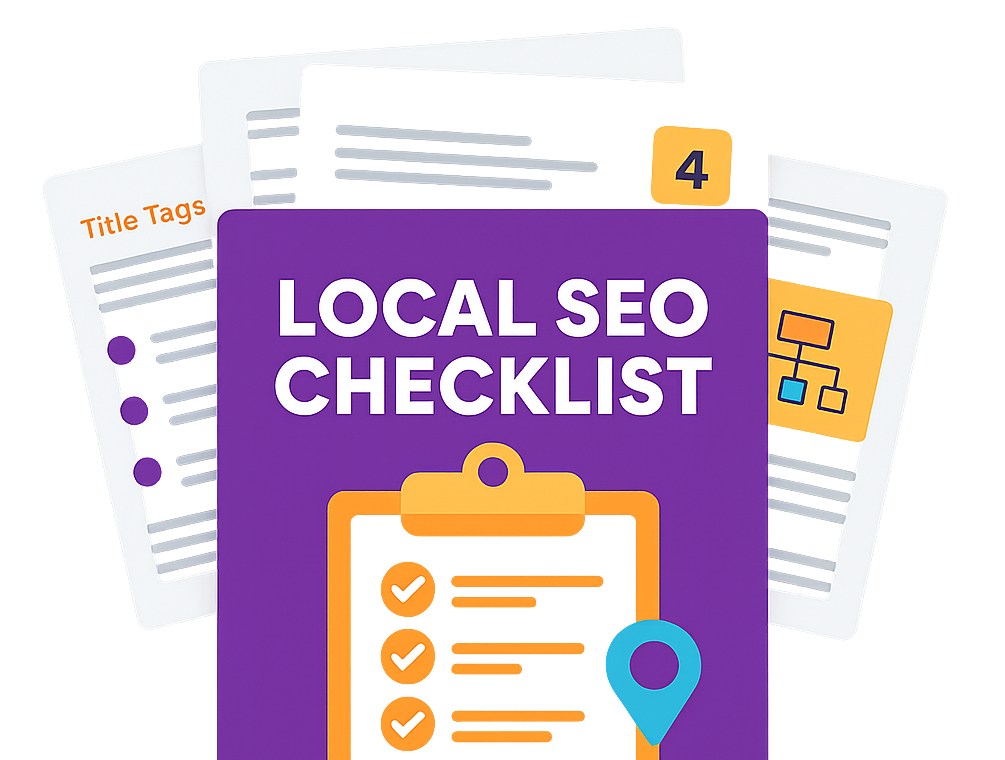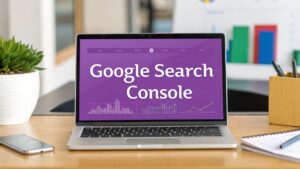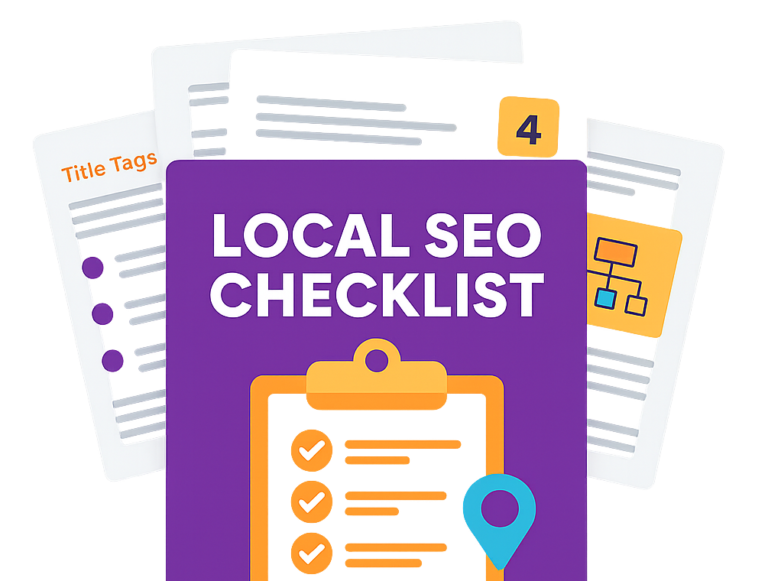A solid local SEO strategy for franchises is all about striking a balance. You need a unified digital brand, but you also have to celebrate what makes each location a unique part of its community. The sweet spot is a combination of a strong, single domain, perfectly tuned Google Business Profiles, and localised content that answers what your customers are actually searching for.
Understanding the Foundations of Local SEO for Franchises
Building a powerful local SEO strategy for a franchise isn't about treating each location as a separate island. Think of it more like an archipelago—a group of islands connected just beneath the surface. They all share strength from a central foundation, but each one thrives in its own local environment.
The goal is simple: make every single one of your outlets the obvious choice for customers in its immediate vicinity.

This approach ensures your brand’s overall authority gives each local branch a boost, while the local activities of each branch strengthen the main brand in return. It's a symbiotic relationship that search engines like Google absolutely love to see.
Why Proximity Searches Are Crucial
The modern customer journey almost always kicks off with a search like "coffee shop near me" or "emergency plumber in Cambridge." This is where a robust local SEO strategy really earns its keep. Local search intent is a massive driver of customer acquisition, and the data tells a compelling story.
Around 46% of all Google searches now have a local intent. That's a huge shift in how people look for services. What’s more, over the past five years, searches including the phrase ‘near me’ have exploded by a staggering 500%.
And it gets better. Franchises with complete and accurate Google Business Profiles are seen as 2.7 times more reputable by potential customers. The value of a well-executed plan is just too big to ignore.
The Core Components of Franchise SEO
To build a winning strategy, you need to focus on several core components that all work together. If you neglect one, you risk weakening the entire structure.
Here’s what forms the backbone of your efforts:
- A Unified Website: All your locations should live on one authoritative domain (e.g.,
yourbrand.co.uk/cambridge). This consolidates your SEO power instead of diluting it across dozens of separate microsites. - Optimised Google Business Profiles (GBP): Every location needs its own meticulously managed GBP listing. Think of this as your digital shopfront on Google Maps and in local search results.
- Consistent NAP Information: Your Name, Address, and Phone number (NAP) must be identical across every single online directory. This is fundamental for building trust with search engines.
- Localised Content: Creating unique content for each location page—content that speaks directly to the local community—is absolutely essential for relevance.
- Reputation Management: You need to actively encourage and respond to reviews for each outlet. This builds social proof and gives your local rankings a serious boost.
To give you a clearer picture, here’s a quick rundown of these essential tactics and why they matter.
| Element | Description | Impact |
|---|---|---|
| Unified Website | A single domain with location-specific pages (e.g., /location-a, /location-b). |
Consolidates domain authority and simplifies brand management. |
| Google Business Profile | A unique, fully optimised profile for each franchise location. | Boosts visibility in local map packs and "near me" searches. |
| Consistent NAP | Uniform Name, Address, and Phone number across all online directories. | Builds trust with search engines and avoids confusing customers. |
| Localised Content | Unique content on each location page relevant to the local area. | Improves relevance for location-specific search queries. |
| Reputation Management | Actively managing reviews for each location. | Increases social proof, customer trust, and local rankings. |
By weaving these elements together, you create a powerful, cohesive strategy that drives visibility at both the national and local levels.
Many of these principles mirror foundational SEO practices for smaller operations. In fact, exploring these SEO tips for small businesses can provide great insights that you can adapt for individual franchise locations. For a deeper dive into managing multiple locations effectively, our guide on https://www.bare-digital.com/local-seo-for-franchisees/ offers more targeted advice.
Building One Domain to Rule Them All
When you're running a multi-location franchise, one of the biggest SEO questions is how to structure your website. Should each location get its own microsite, or should everything live under one roof?
From my experience, a unified website structure is almost always the way to go. It channels all your link equity—what we used to call 'link juice'—into one powerful domain. This means every backlink contributes to the authority of the whole site, lifting every single franchise page along with it.
Splitting your presence across multiple microsites just dilutes your authority and makes content management a nightmare.
According to the experts at Mayfly Internet Marketing in their 2025 franchise SEO guide, a consolidated website is the most effective strategy for UK franchises. It streamlines how Google sees your brand and distributes authority across all your local pages, giving you a much faster path to ranking. For a deeper dive, check out Mayfly’s franchise SEO strategies.
Just look at the numbers for typical UK franchises.
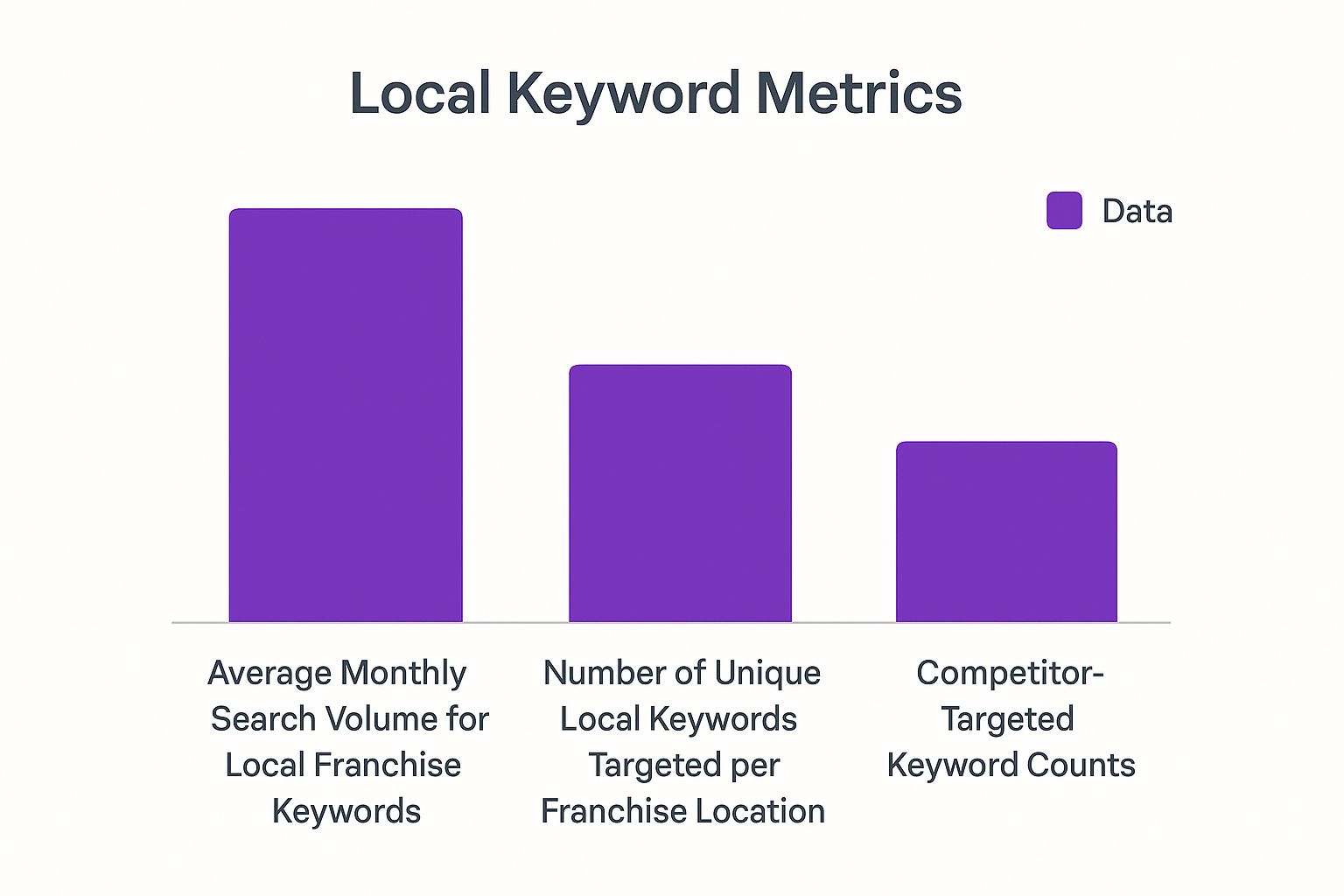
This data shows that businesses with a single, consolidated domain often target 50% more local keywords per location, all while holding their own against competitors on search volume. It's a clear win.
Site Architecture Essentials
Getting the structure right from the start is crucial. It needs to be logical for both users and search engine crawlers.
- URL Hierarchy: Keep it clean and simple. A structure like
yourbrand.co.uk/locations/londontells everyone exactly what the page is about. No confusion. - Navigation Design: A golden rule is the three-click rule. Can a visitor get from your homepage to any franchise page in three clicks or less? If not, your navigation is too complicated.
- Template System: You need a solid template for your location pages. This ensures brand consistency while leaving room for unique local details.
Think of a national café chain. They might have a standard template for all their locations, but the Manchester page will feature menus and promotions specific to that city. It's the perfect blend of brand unity and local flavour.
To put it simply, the single-domain approach just makes more sense from an SEO and operational standpoint.
Domain Structure Comparison
| Metric | Consolidated Domain | Individual Microsites |
|---|---|---|
| Link Equity Distribution | Link equity is shared, strengthening all pages. | Authority is diluted across many separate sites. |
| Maintenance Complexity | Much simpler. Update one site, not dozens. | A massive headache. Multiple sites to update and secure. |
| Local Keyword Targeting | Can target up to 30% more keywords per location. | Standard targeting capacity, often less effective. |
The takeaway is clear: consolidating under one domain doesn't just supercharge your SEO; it also slashes your ongoing maintenance costs and effort.
Centralising under one domain not only strengthens SEO performance but also reduces ongoing maintenance costs.
Smart Internal Linking
Once your architecture is in place, it's time to connect the dots with smart internal linking. This isn't just about throwing links around; it's about creating a logical path for users and search engines.
- Contextual Links: On your main service pages, link out to specific locations using city-based anchor text, like "boiler repair services in Bristol."
- Silo Structure: Group related content together. For instance, all blog posts about London-specific news should link to the London location page, creating a topical silo.
- Cross-Linking: When you launch a new franchise page, link to it from some of your high-authority pages (like your homepage or a popular blog post) to give it an instant authority boost.
A well-thought-out internal linking strategy is like a roadmap, guiding both people and Google to your most important pages.
Schema Markup Boost
Now for a slightly more technical, but incredibly powerful, tactic: Schema markup. This is code you add to your pages that helps search engines understand the nitty-gritty details about each franchise location.
- LocalBusiness Schema: This is the big one. It spells out your exact address, phone number, and even geo-coordinates for each location.
- OpeningHoursSpecification: Tell Google precisely when each outlet is open, including special hours for holidays.
- Review Schema: Got great local reviews? Use this schema to highlight them. This can make your search snippets stand out.
Adding this layer of detail can earn you rich results in search, which I've seen drive click-through rates up by as much as 20%. It’s a small effort for a potentially huge reward.
By combining a clean site structure, strategic linking, and detailed schema, you create a powerful, scalable single domain that crushes local SEO for every single franchise location.
Ongoing Maintenance
Of course, your work isn't done after the initial setup. A single-domain strategy needs regular TLC to stay effective, especially as you add more locations.
- Crawl Reports: Run regular site crawls to find and fix broken links or orphan pages that have lost their connection to the main site.
- Content Review: Keep things fresh. Update pages with seasonal promotions, local event info, and new staff photos. Stale content gets ignored.
- Analytics Check: Dive into your analytics. See which location pages are performing well and which are lagging. Use that data to adjust your priorities.
Staying on top of maintenance prevents small issues from snowballing and eroding your site's hard-won authority. A well-oiled machine ensures every franchise location keeps pulling its weight, delivering value to both your customers and your bottom line.
Getting to Grips With Google Business Profiles at Scale

For any franchise, your Google Business Profile is the absolute centre of your local search presence. It’s what gets each outlet seen in the local pack and map results. The key? Rigorous consistency. Google needs to trust that your Name, Address, and Phone (NAP) details are identical everywhere.
Here’s where to start:
- Claim and verify every single location. Google’s bulk verification tool is your friend here, so use it to get every listing approved without the headache of individual postcards.
- Maintain iron-clad NAP uniformity across Google Maps, online directories, and your own website. Getting this right can deliver a 28% boost in local SEO performance.
- Categorise each profile properly. Don't just stick with a primary category; add secondary ones that reflect specific services and what locals are actually searching for.
- Schedule weekly Google Posts to keep profiles looking active. Share offers, announce events, or post some community news.
- Rotate in high-quality photos and short videos every month. Show off real customers, the team, and the local atmosphere of each branch.
Crafting Descriptions That Actually Convert
A generic business description is a wasted opportunity. A keyword-rich one, on the other hand, can turn a basic listing into a genuine customer magnet. Think about it from a searcher's perspective. A garden centre in Leeds mentioning “organic compost delivery Leeds” in its description is directly answering a local need. This simple tactic contributes to a 31% visibility increase for profiles that do it well.
To keep things consistent, give your franchisees a simple template. Start with a 750-character summary that weaves in primary keywords naturally. Follow it up with two bullet points on top services and a final sentence with a local call-to-action.
Engaging descriptions don't just signal relevance to Google for specific local searches; they drive immediate clicks from real people.
Optimising your Google Business Profile isn’t just a nice-to-have; it accounts for an estimated 19.2% of local search ranking signals. UK franchises that update their posts regularly appear 2.8 times more often in top map results. You can dig into more of these stats over at SQ Magazine.
Nailing Your Review Management Strategy
Nothing builds community trust like prompt, personalised review responses. When someone leaves positive feedback, aim to respond within six hours—this alone can boost engagement by 38%. For negative replies, always offer clear steps for resolution.
Here’s a practical workflow for managing reviews across multiple locations:
- Set up real-time alerts for new reviews on Google, Facebook, and any key industry directories.
- Create a library of response templates, but always personalise each message with customer-specific details.
- Encourage more reviews with in-store QR codes or post-visit email and text reminders.
- Have a clear process for escalating unresolved complaints to a local manager for follow-up.
A steady stream of diverse reviews is a powerful ranking factor that perfectly complements your local SEO strategy for franchises. For a deeper dive, check out our Bare Digital Google My Business optimisation guide.
How to Handle Bulk Profile Updates
Managing dozens of profiles one by one is a recipe for mistakes and wasted time. Using Google’s API or a dedicated listings management platform lets you push crucial updates to all your GBP entries at once. This approach cuts down on manual errors and ensures rock-solid consistency at scale.
- Sync new franchise openings automatically, making sure every new outlet is visible from day one.
- Apply temporary closures or special hours across a group of locations with a single action.
This scalable method frees up your team to focus on what really matters—local promotions and genuine customer outreach. Just be sure to regularly review audit logs to catch any discrepancies before they can impact your visibility.
Ultimately, mastering a fleet of Google Business Profiles requires a smart blend of automation and a human touch. By putting these workflows in place, you can ensure every single one of your outlets shines in local search and drives foot traffic through the door.
Creating Content That Speaks to Locals
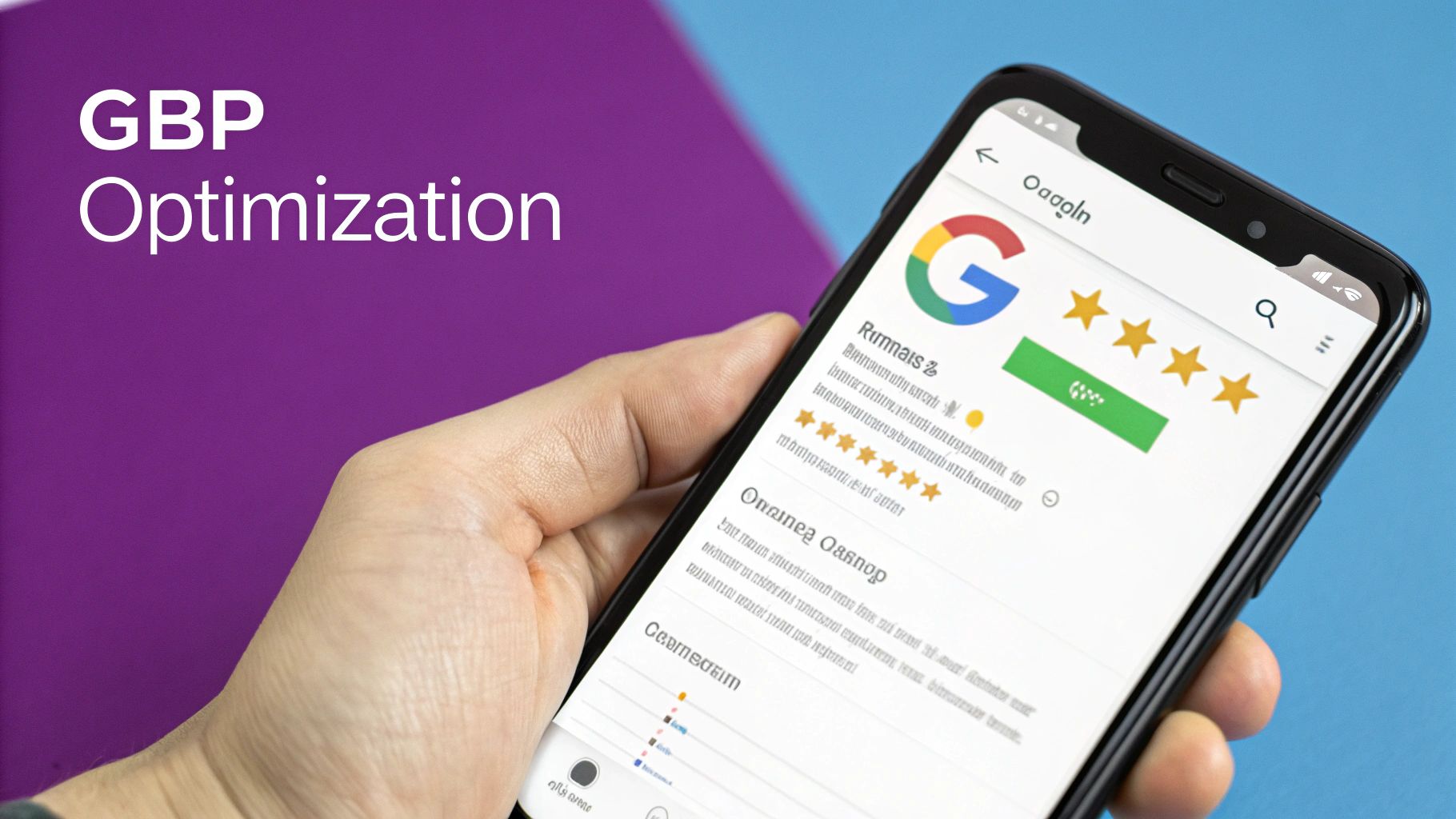
Once your website structure and Google Business Profiles are sorted, it’s time for the real work: creating hyperlocal content that actually connects with local customers. This is what truly separates a successful local SEO strategy for franchises from one that falls flat.
We need to move beyond the generic, corporate-approved copy. While a template is a decent starting point for brand consistency, the magic happens when you infuse each location’s page with details that only a local would recognise.
Weaving in Local Flavour
Think of your location landing pages as prime real estate for targeting those hyper-specific local keywords. "Plumbers in London" is far too broad. A franchise based in Islington should be going after phrases like "emergency boiler repair in Islington" or "unblocking drains near Angel."
The trick is to weave these terms into genuinely useful content. Here are a few ways I’ve seen this work brilliantly:
- Highlight Local Partnerships: Does the Cambridge branch sponsor a local youth football team? Get it on their page. This builds authentic local relevance and can even land you some valuable backlinks.
- Showcase Local Staff: Adding short bios and photos of the team on the ground instantly builds trust. It puts a face to the business, making the brand feel much more approachable and part of the community fabric.
- Feature Community Events: Pop a simple calendar on the page showing local events your franchise is involved in. It could be anything from sponsoring a market stall to hosting a free workshop.
This level of detail signals to Google that your page is a proper local resource, not just another cookie-cutter clone. It proves you're invested in the area, and both search engines and customers love to see it.
By creating content that reflects the local culture, events, and language of each franchise area, you transform a generic webpage into a powerful, community-focused hub that drives engagement and conversions.
Technical Optimisation for Local Pages
Great copy is only half the battle. Your technical setup needs to be spot-on to help your local content rank where it matters. These on-page optimisations make it crystal clear to search engines where you are and what you do.
- Location-Specific Meta Titles: Your meta title is one of the most powerful on-page SEO factors you have. Make it count by including the city and a primary service. Something like: "Artisan Coffee & Cake Shop in Brighton | Your Brand Name".
- Local Business Schema: This is non-negotiable. Implementing LocalBusiness schema markup on each location page explicitly feeds Google the precise NAP (Name, Address, Phone), opening hours, and even the geo-coordinates for each outlet.
- Geo-Targeted FAQs: Add an FAQ section answering questions specific to that location. For a gym in Manchester, you might answer, "Do you offer student discounts for University of Manchester attendees?" This is a fantastic way to capture valuable long-tail search traffic.
Building out these individual content assets is a fundamental part of any solid local SEO plan. For a deeper dive, our guide on content marketing strategies for local SEO has plenty more tactics you can put into action.
Scaling Citations and Reviews for Growth
Beyond your website and Google Business Profiles, a solid network of consistent business citations is a massive trust signal for search engines. Think of every mention of your franchise’s Name, Address, and Phone number (NAP) across the web as a vote of confidence. When all those votes match up, Google trusts that your locations are legitimate and where you say they are.
But trying to manage this for dozens—or hundreds—of locations is a monumental task. The key is to be methodical. You need to start by pinpointing the most valuable UK directories. Big names like Yelp, Yell, and Thomson Local are non-negotiable, but don’t forget about the industry-specific sites relevant to your franchise’s niche. They often carry more weight.
Automating and Cleaning Up Your Listings
Once you have your target list, the real work begins. Manually updating every single listing just doesn’t scale. This is where citation management tools become your best friend. They let you audit your existing online footprint, push out consistent NAP data across dozens of directories at once, and—most importantly—hunt down and fix incorrect listings that are actively hurting your local rankings.
Mismatched or outdated information creates confusion for search engines and erodes customer trust. A single wrong phone number on a popular directory can lead to lost leads and a noticeable drop in local search visibility.
Regularly auditing your citations isn't a one-and-done job. It's an ongoing process. Every time a new location opens, it needs to be added correctly, and you have to be vigilant to ensure old, incorrect data doesn't creep back in. This proactive approach is a cornerstone of any effective local seo strategy for franchises.
Fuelling Growth with Customer Reviews
Citations build trust with search engines, but it's reviews that build trust with actual people. And the numbers don't lie: research shows that 87% of consumers read online reviews for local businesses. A steady stream of positive, recent feedback is one of the most powerful conversion tools you have at your disposal.
The real challenge is getting a consistent flow of reviews across all your locations. This calls for a proactive review-generation campaign.
- In-Store Prompts: Simple QR codes on receipts, menus, or posters that link directly to your Google review page can work wonders. Make it easy for happy customers.
- Email & SMS Follow-ups: After a purchase or service, send a polite, automated request for feedback. Keep it simple, direct, and personal.
- Team Incentives: Encourage your staff to mention leaving a review to clearly satisfied customers. A little friendly internal competition between locations can go a long way.
Managing Your Reputation at Scale
Getting the reviews is only half the battle. You also have to respond—to both the good and the bad. A prompt, professional response to a negative review can often turn a poor experience into a public display of excellent customer service. Likewise, thanking a customer for a positive review shows you’re engaged and genuinely appreciate their business.
For a deeper look at how all these different tactics fit together, you can explore our comprehensive guide on powerful local SEO strategies. It helps connect the dots between your citation and review efforts and your wider marketing goals.
For franchises, using a reputation management tool is vital. It allows a central team to monitor reviews for all locations from a single dashboard, ensuring no feedback slips through the cracks and the brand's voice remains consistent in every reply.
Your Franchise Local SEO Questions Answered
Digging into a local SEO strategy for franchises always brings up a lot of questions. Getting straight answers is the only way to avoid the common slip-ups that can sink all your hard work. Here, I'm going to tackle some of the most frequent queries we hear from franchise owners and marketing managers.
This isn't just theory—it's about giving you actionable solutions to make sure every single location in your network is geared up for local search success.
What Is the Best Way to Set Up Local Pages for Each Franchise Outlet?
Always, and I mean always, keep every location under a single, authoritative domain. This is non-negotiable. It channels all your SEO power into one central hub, making your entire brand stronger.
From there, use a clean and logical URL structure, something like yoursite.co.uk/locations/city-name. You should start with a consistent page template to keep the brand unified, but the magic is in the customisation. Add photos of the local team, sprinkle in testimonials from customers in that specific area, and mention nearby landmarks to build a genuine community connection.
How Often Should We Really Update Our Google Business Profiles?
You’ve got to be consistent. It’s a massive signal to Google that your business is active, open, and relevant to people searching nearby. A profile that just sits there collecting dust will quickly lose its visibility.
Try to add a new Google Post at least once a week to shout about offers or news. Get some fresh photos uploaded monthly to keep the listing looking sharp. And most importantly, make it a rule to respond to new customer reviews within 24 hours. It shows you’re engaged and actually care about what your customers think.
How Do We Prevent Duplicate or Incorrect Business Citations?
Inaccurate information is a huge red flag for search engines and a quick way to damage trust. The first move is to use a citation management tool to run a full audit and clean up the mess of existing listings scattered across the web.
Moving forward, establish a strict process. Only one authorised person—or your designated marketing partner—should be responsible for creating and editing directory listings. This central control is absolutely vital for preventing the inconsistencies that can wreck your local rankings.
Is Local Link Building Actually Worth the Effort for a Franchise?
One hundred percent, yes. Local link building is one of the most powerful things you can do to weave your brand into the fabric of a community. It goes so much further than just standard directory listings.
Think about sponsoring a local charity fun run, teaming up with a nearby, non-competing business for a joint promotion, or getting a feature on a local news blog. These aren't just link-building exercises. They build powerful, relevant links while also driving real-world brand awareness and getting people through your doors. It shows a genuine investment in the local area, something both customers and search engines will reward you for.
Ready to implement a powerful local SEO strategy that drives real growth for every one of your franchise locations? At Bare Digital, we specialise in creating bespoke SEO plans that deliver measurable results. Get your free SEO Health Check today and discover how we can boost your visibility, traffic, and conversions.


